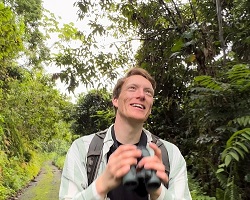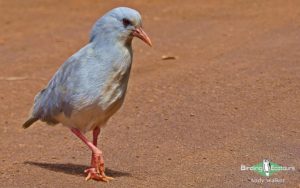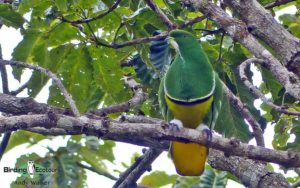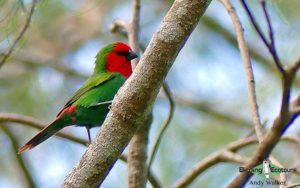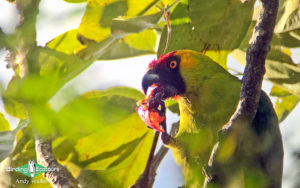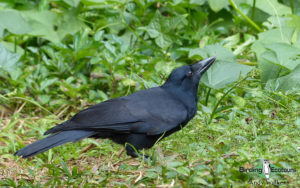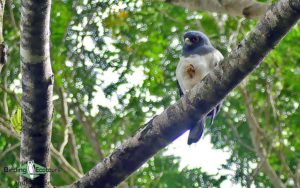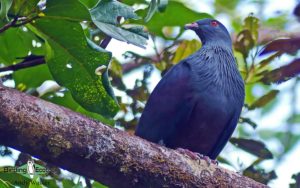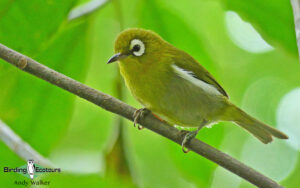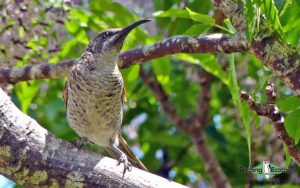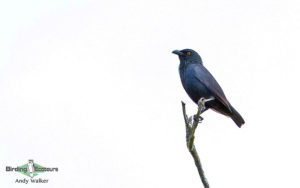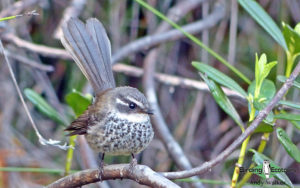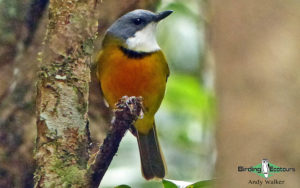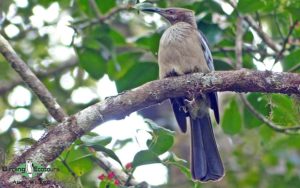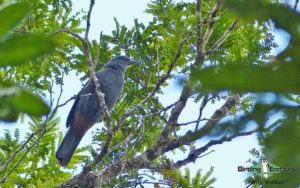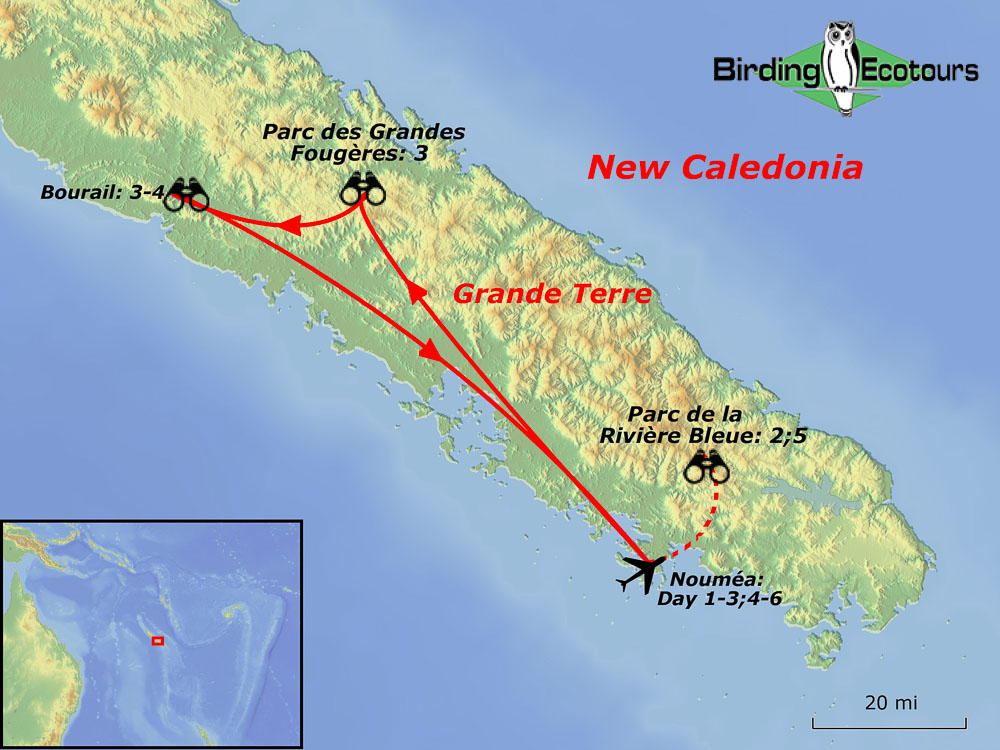Birding Tour New Caledonia: Kagu and Other Endemics
Birding Tour New Caledonia: Kagu and Other Endemics
August 2026/2027
This small group, short tour visits the island of Grande Terre, New Caledonia, and focuses on the many exciting endemic birds found across the island. New Caledonia is an ancient island archipelago comprised of over 100 islands of Gondwanan (continental) origin, our tour visits the largest island of Grande Terre. Starting in Nouméa the capital city, we travel north along the western coastline to Bourail while exploring some of the most picturesque national parks on the island, before finishing back in Nouméa. Most of the island is covered in tropical evergreen forest at higher elevations, while savanna and maquis dominate the lower elevations. Most famous for being the home of the unique Kagu (a highly sought-after monotypic family), Grande Terre hosts over 20 endemic birds as well as about a dozen more Melanesian endemics. We will spend time birding dense evergreen forests in the stunning Parc des Grandes Fougères (Great Tree Fern Park), various wetlands and coastal sites, and maquis and dry forests of La Farino reserve and the extensive Parc de la Rivière Bleue. Parc de la Rivière Bleue is renowned to birdwatchers, being the home of our prime target and New Caledonia’s endemic star bird, the charismatic Kagu. We have two full days within the park to ensure a good chance of seeing this iconic species well.
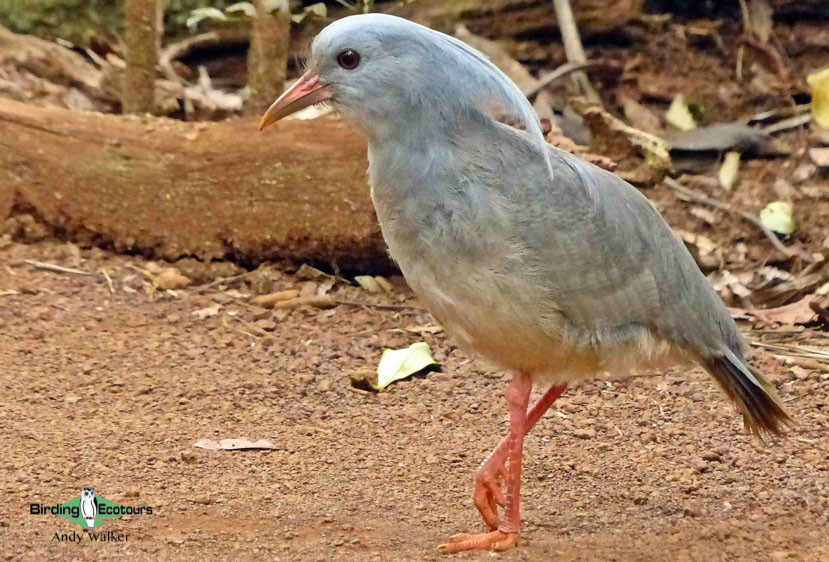
Most endemics found on Grande Terre should be encountered during our time here, and these include White-bellied Goshawk, Kagu, Cloven-feathered Dove, Goliath Imperial Pigeon, Horned Parakeet, New Caledonian Parakeet, New Caledonian Myzomela, Barred Honeyeater, New Caledonian Friarbird, New Caledonian Whistler, New Caledonian Streaked Fantail, the tool-using New Caledonian Crow, New Caledonian Cuckooshrike, Yellow-bellied Flyrobin, Green-backed White-eye, Striated Starling, and Red-throated Parrotfinch. Two species, the Critically Endangered (IUCN) Crow Honeyeater and the increasingly rare New Caledonian Thicketbird, are becoming more difficult year on year but we will still try to find them in suitable areas where they may still be hanging on. Unfortunately, four endemic species are now considered likely to be extinct with no recent sightings, these include New Caledonian Nightjar, New Caledonian Owlet-nightjar, New Caledonian Rail, and New Caledonian Lorikeet, in addition, New Caledonia Buttonquail is so rare that it hasn’t been seen since the early 1900s and the recently split New Caledonian Island Thrush is now restricted to small outlying islands.
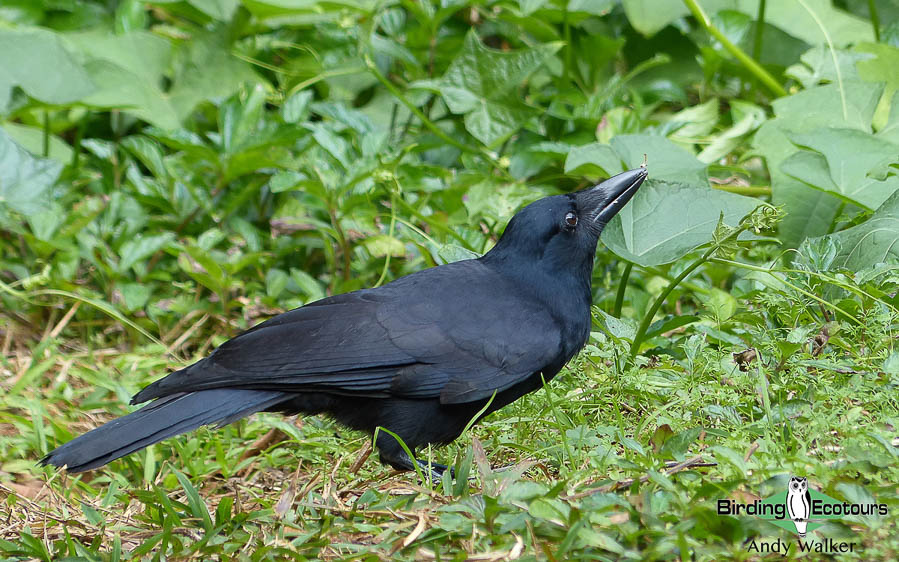
If you would like to extend your time in New Caledonia, we can offer extensions to visit either, or both, of the nearby islands of Lifou and Ouvea (both part of New Caledonia). These islands are home to several endemic and range-restricted species not found on the main island of Grande Terre such as Ouvea Parakeet, Small Lifou White-eye, Large Lifou White-eye, Red-bellied Fruit Dove, Melanesian Whistler, Cardinal Myzomela, and Blue-faced Parrotfinch. Please just ask us about these optional extras and we would be happy to help.
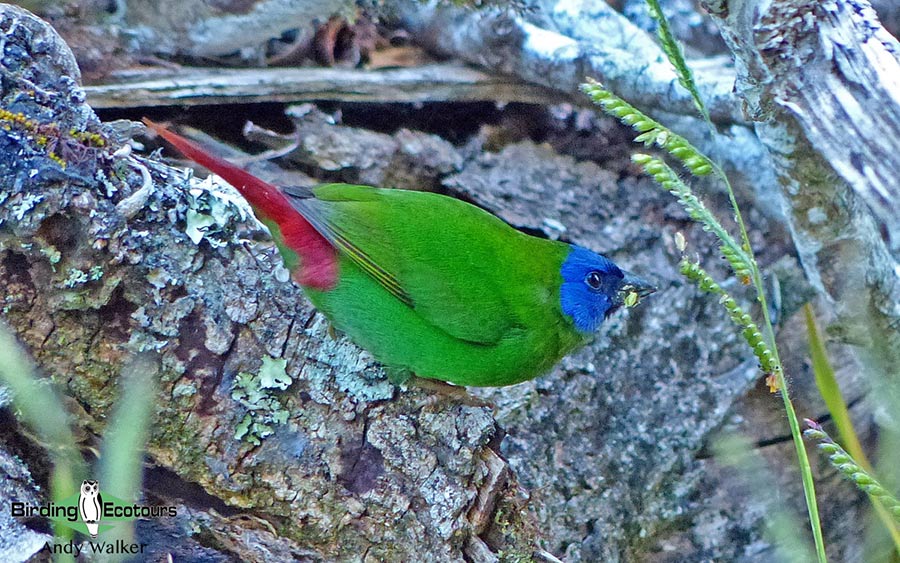
This is an ideal tour to combine with our other tours visiting Melanesian islands as it fits perfectly between our Vanuatu Pacific Islands Extension tour, and our Fiji and Samoa Pacific Birding Adventure. On Vanuatu we target the elusive Vanuatu Megapode, the beautifully colorful Golden, Orange and Whistling Doves in Fiji, and the interesting Mao in Samoa. Combining these tours will give you an excellent list of Melanesian species, including some highly sought-after and charismatic endemic species, while visiting four beautiful island-paradises
Itinerary (6 days/5 nights)
Day 1. Arrival in New Caledonia
Arrival at La Tontouta International Airport, Grande Terre, New Caledonia, and transfer to our hotel in Nouméa. Afternoon at leisure relaxing in our comfortable beachside hotel. Our tour will start in the evening with a group welcome dinner.
Overnight: Nouméa
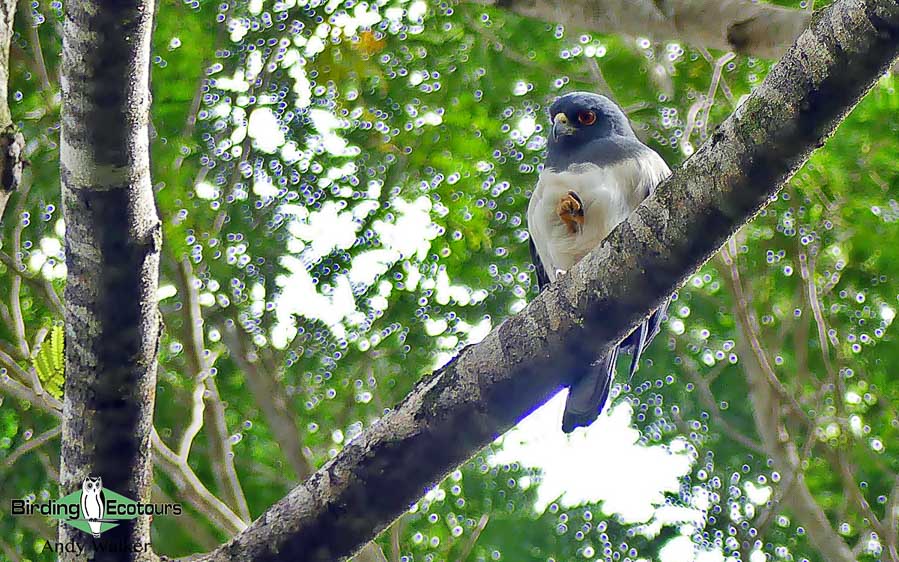
Day 2. Full day birding at Parc de la Rivière Bleue
With an early start, we will travel to Parc de la Rivière Bleue in search of endemic birds, including the star endemic, the flightless and extremely rare Kagu. We will concentrate on finding this remarkable bird, aiming for extended views and hopefully capturing some photographs along the way. While searching for the Kagu we are likely to come across many other endemics and regional specials in this excellent and expansive reserve. We have a good chance of seeing the world’s largest arboreal pigeon, the hulking Goliath Imperial Pigeon, and the stunningly beautiful Cloven-feathered Dove, alongside the New Caledonian Crow, which is famous owing to its tool-using foraging behaviors. This is our best chance for the Critically Endangered (IUCN) Crow Honeyeater, a bird which is unfortunately getting harder and harder to find each year. Other brilliant species we will target include New Caledonian Parakeet, New Caledonian Myzomela, Barred Honeyeater, New Caledonian Friarbird, Green-backed White-eye, Fan-tailed Gerygone, Metallic Pigeon, New Caledonian Streaked Fantail, Sacred Kingfisher, South Melanesian Cuckooshrike, New Caledonian Cuckooshrike, Horned Parakeet, Southern Shrikebill, Yellow-bellied Flyrobin, Red-throated Parrotfinch, and White-bellied Goshawk.
Overnight: Nouméa
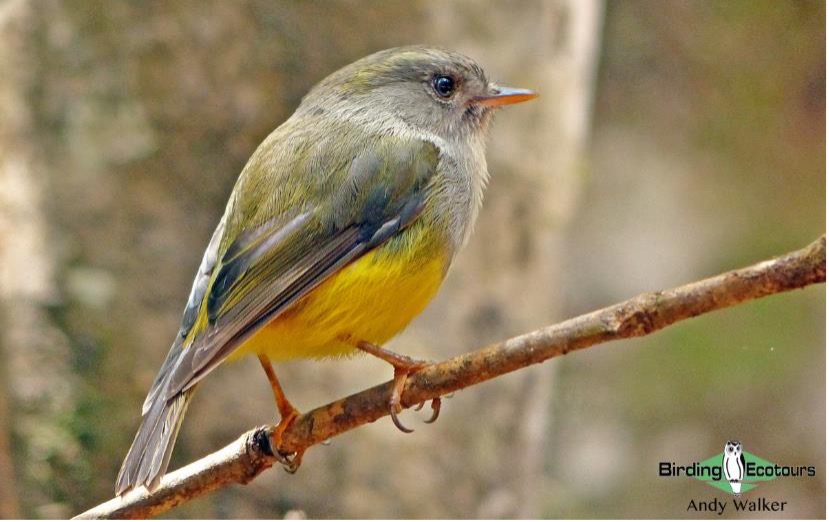
Day 3. Birding Parc des Grandes Fougères
We will leave the capital city early and travel northwest to explore Parc des Grandes Fougères (Great Tree Fern Park), a prehistoric forest dominated by giant tree ferns. While birding here you will feel like you have gone back in time! Within the lush forests we will search for the spectacular Cloven-feathered Dove, New Caledonian Crow, Goliath Imperial Pigeon and beautiful Horned Parakeet which are more common in this habitat. We could also find White-bellied Goshawk, an endemic raptor that nests in the forests here. With more than 70 species recorded in the park, we’ll find plenty of other great birds throughout the morning, such as Southern Shrikebill, Yellow-bellied Flyrobin, New Caledonian Whistler, and Striated Starling. The forests here also have a population of Kagu that is increasing in size due to predator control, so we may again bump into this unique species. In the mid-afternoon, we continue travelling northwest to our accommodation in Bourail in the central section of Grande Terre, to position ourselves well to target one of the most secretive of New Caledonia’s endemics tomorrow.
Overnight: Bourail
Day 4. Full day birding the Farino area
This morning we will visit the Bourail grasslands to target the shy and rare, yet charismatic New Caledonian Thicketbird. This is a super-skulking species and will require patience, but we are working with a great local guide who knows the site and this species well so we hope to find them. We will also look for the local and nomadic Red-bellied Fruit Dove, a Melanesian endemic, and Red-throated Parrotfinch, another brilliantly coloured New Caledonian endemic. In the afternoon we head south for a two-night stay in Nouméa, via a few stops at some wetlands. Here we may see Buff-banded Rail, Hardhead, Swamp Harrier, Shining Bronze-Cuckoo, Satin Swiftlet, amongst many others. On previous tours we have found some great birds, such as White-browed Crake, a national rarity.
Overnight: Nouméa
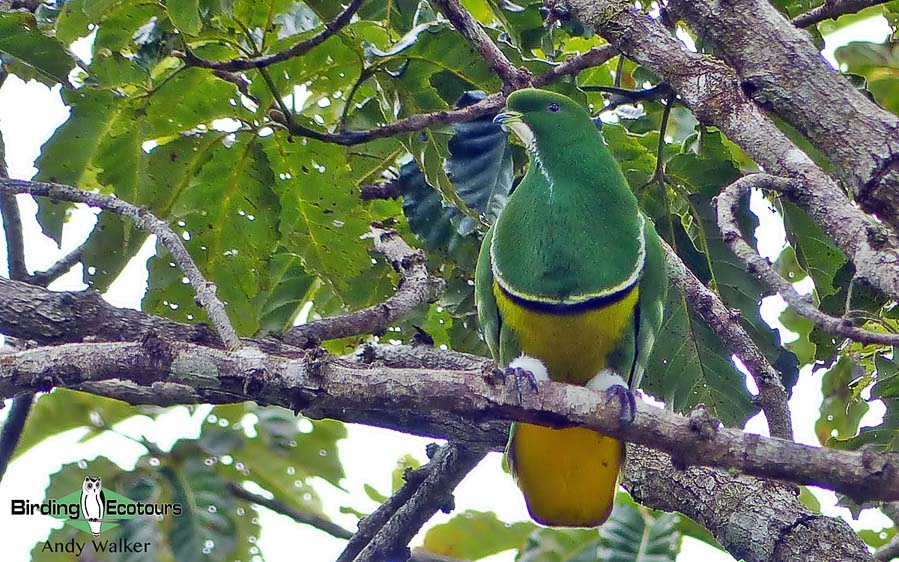
Day 5. Full day birding at Parc de la Rivière Bleue
We return to the beautiful Parc Provincial de la Rivière Bleue looking for any endemics that might still be missing. We will focus on getting good views and photographs of Kagu and other tough endemic birds, such as Crow Honeyeater and New Caledonian Parakeet. Yet this park is one of the most avian diverse sites on Grand Terre, so it is likely we will increase our species list while spending time here, with Melanesian Flycatcher, Long-tailed Triller, and White-rumped Swiftlet possible, in addition to the species already listed under Day 2.
Overnight: Nouméa
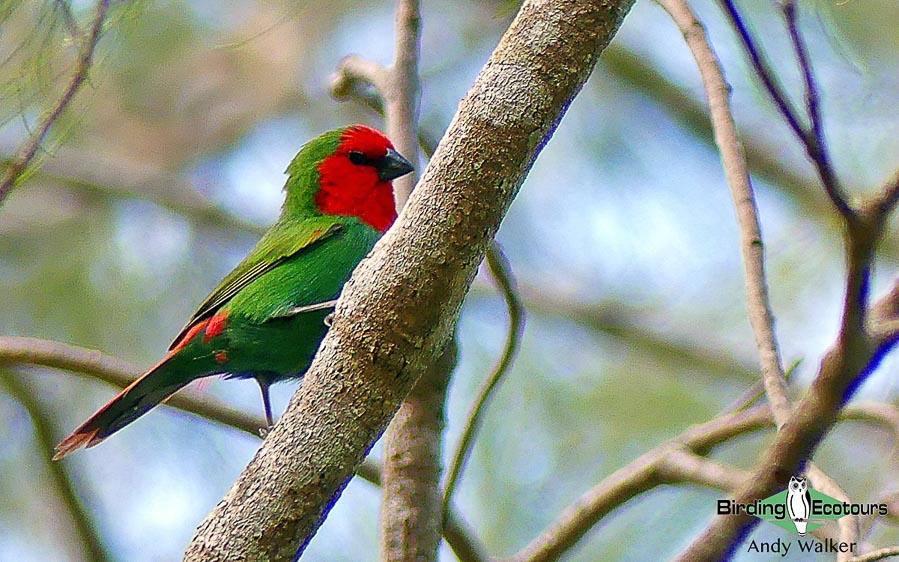
Day 6. Transfer from Nouméa to La Tontouta International Airport, departure
We will have time for some morning birding around our hotel grounds and the local area, seeking out any other endemics or regional specials, such as Red-throated Parrotfinch, Grey-eared Honeyeater, and Green-backed White-eye. After our final birding session we will transfer back to La Tontouta International Airport, where this short but endemic-packed tour concludes in the mid-afternoon. Those continuing on the Fiji and Samoa Pacific Birding Adventure tour will fly to Nadi, in Fiji, the following day.
Overnight: Not included
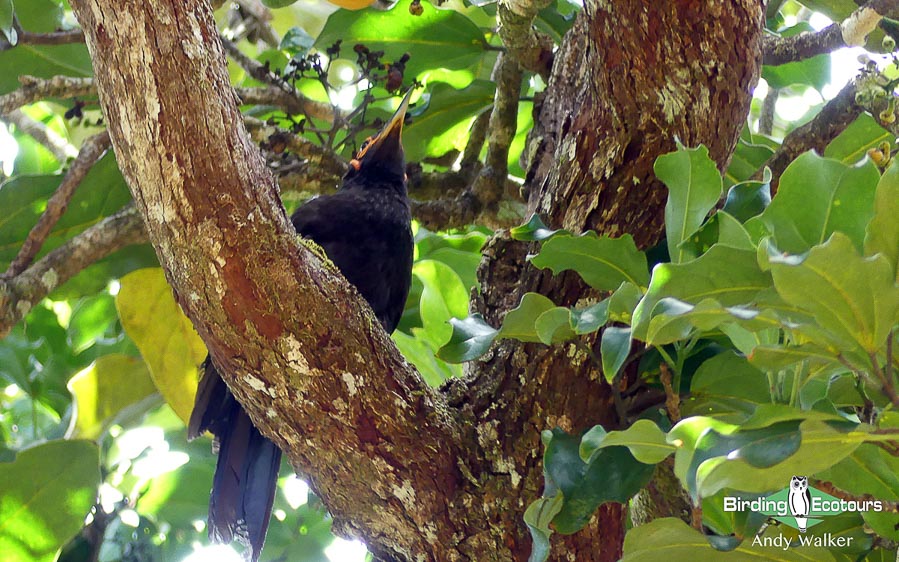
Please note that the itinerary cannot be guaranteed as it is only a rough guide and can be changed (usually slightly) due to factors such as availability of accommodation, updated information on the state of accommodation, roads, or birding sites, the discretion of the guides and other factors such as internal flight availability. In addition, we sometimes have to use a different international guide from the one advertised due to tour scheduling.
Download ItineraryBirding Tour New Caledonia: Kagu and Other Endemics Set Departure Trip Report, September 2025
03 – 08 SEPTEMBER 2025
By Fraser Bell
DOWNLOAD TRIP REPORT
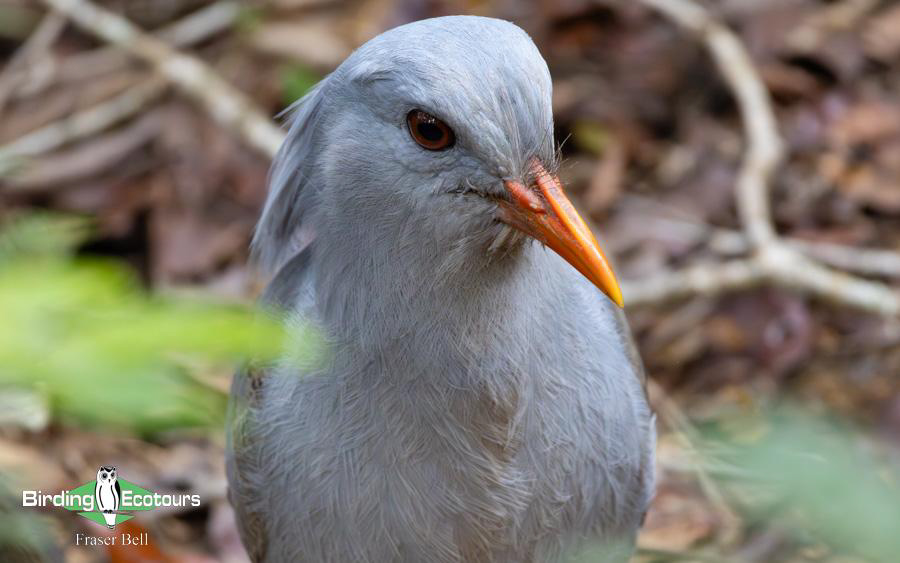
Watching groups of brilliant Kagus was an amazing and memorable experience. They were unique, bold and inquisitive, making for some incredible close encounters.
Overview
This six day birding tour of New Caledonia began in the capital city Nouméa on 3rd of September 2025 and concluded there on 8th September 2025. The tour aimed to see all of the currently recognized and extant endemic bird species found on New Caledonia’s largest island, Grand Terre, and localized Melanesian species also found in Vanuatu and the Solomon Islands. We succeeded in seeing all of our targets, including brilliant close, repeat encounters with Kagu, great views of a singing Crow Honeyeater, and a vagrant Eurasian Coot which was a first for New Caledonia!
As all tour participants had just completed our Fiji and Samoa Pacific birding adventure, our tour of New Caledonia started early, with a morning birding the parks and sea front of Nouméa, which was a great introduction to birding in New Caledonia. Our second day was spent exploring the stunning and unique landscape at the fabulous Parc de la Rivière Bleue (Blue River Provincial Park), where we found most of our endemic targets. The following morning we checked out of our hotel in Nouméa and drove north along the western coastline to explore the prehistoric Parc des Grandes Fougères (Great Ferns Park) in the Farino area, before transferring to our coastal resort for the night near Bourail. We then spent a day birding the grassland, coastal forests and wetlands of the area, before driving back to again stay at our comfortable hotel in Nouméa. For our final full day we returned to the brilliant Parc de la Rivière Bleue, then spent the last morning birding locally in Nouméa.

Cloven-feathered Dove is endemic to New Caledonia and is one of the best looking, and most unusual doves in the world.
We recorded 71 bird species on this birdwatching tour of New Caledonia, including all 19 endemics found on the island of Grand Terre, such as Kagu, the stunning Cloven-feathered Dove, massive New Caledonian Imperial Pigeon, Horned Parakeet, New Caledonian Cuckooshrike, famously intelligent New Caledonian Crow, skulking New Caledonian Thicketbird, and the IUCN/BirdLife International Critically Endangered Crow Honeyeater. We also enjoyed seeing many Melanesian specialties such as the gorgeous Red-bellied Fruit Dove, Southern Shrikebill, South Melanesian Cuckooshrike, and Long-tailed Triller. Many of these species encounters were over an extended period of time, with great opportunity for watching these localized species and photographing them. We also had a big surprise discovery by finding a first for New Caledonian in the form of a Eurasian Coot, a vagrant which had previously been unrecorded in the country. Bird and animal lists for this New Caledonia birding tour follow the report and you can also view the eBird trip report here, where you can see more bird photos.
In addition to the exceptional birding, we enjoyed experiencing New Caledonia’s unique and beautiful landscapes, from the Maquis (a specialized type of savanna), diverse Araucaria and fern species, bright red soils and crystal waters of the Blue River Provincial Park, to walking trails through the prehistoric Giant Tree Ferns Park, while watching Kagu rummaging in the leaf litter. Throughout the tour we enjoyed high quality accommodation and food which, combined with the birds and landscapes, made for an exceptionally fun birding tour.

The curious Yellow-bellied Flyrobin is a common sight in New Caledonia’s rainforest. This individual joined us for our picnic lunch while we were birding in the Blue River Provincial Park.
Detailed Report
Day 1, 3rd September 2025. Birding Nouméa
With all participants having arrived early for the tour, having just completed our birding adventure across Fiji and Samoa, we made use of our extra time and started birding after our French buffet breakfast. We spent the morning in the southeast of Nouméa, birding the Ouen Toro hill and seeing many species widespread across New Caledonia. Vibrant Coconut Lorikeets flicked past overhead, Gray-eared Honeyeaters chattered in the scrub forest around us, and flocks of Silvereyes and endemic Green-backed White-eyes busily jostled at flowering trees. We saw both Shining Bronze Cuckoo and a Fan-tailed Cuckoo, both gave good views and the latter was the only sighting of the species on the tour. Other highlights included large groups of Satin Swiftlets, two Brown Goshawks, Rufous Whistler, Common Waxbill, and many opportunities to enjoy the acrobatics of Grey Fantail. Walking back along the sea front we added Silver Gull, Greater Crested Tern and, over lunch, enjoyed watching a pair of Ospreys attending their nest right along the promenade, before having the afternoon at leisure. It was a brilliant start to the tour!
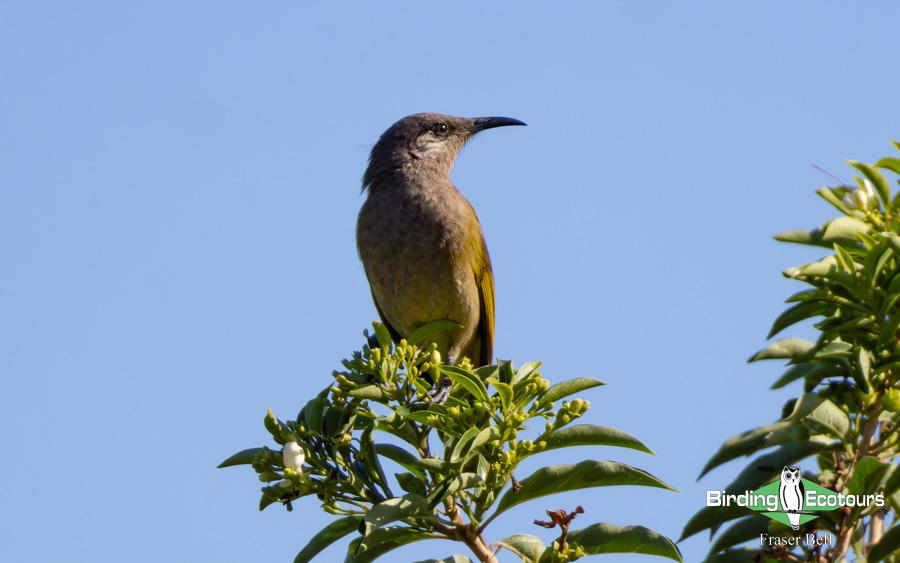
Grey-eared Honeyeater is only found on New Caledonia and Vanuatu.
Day 2, 4th September 2025. Birding the famous Parc de la Rivière Bleue
With an early start we left Nouméa and drove north, pausing at a boulangerie to pick up a breakfast drink and a picnic lunch, then onwards to the brilliant Parc de la Rivière Bleue (Blue River Provincial Park). A chance sighting of an unusual day flying Pacific Flying Fox would be the only native mammal we saw on the trip. We spent the whole day in this beautiful and unique park. Birding here was an amazing experience, we felt like we had gone back in time, back to Gondwanan days when ancient forests and wildlife dominated. Much of the park is dominated by maquis savannah, with pockets of rainforest crossed with crystal-clear blue rivers, and set upon bright red soil. This is one of the most interesting locations to birdwatch in the world, and we spent the day in awe at the landscape, plants and, of course, the birds.
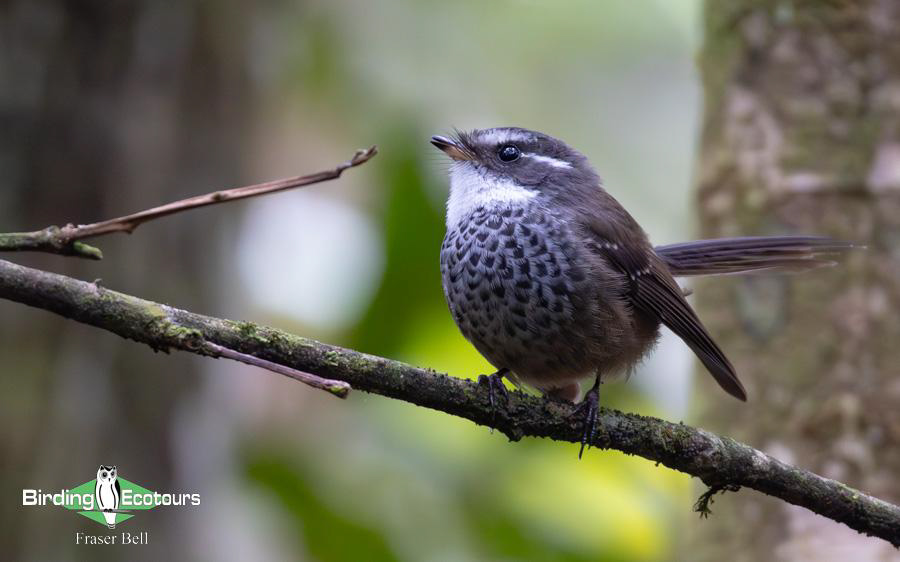
New Caledonian Streaked Fantail was a lively bird, often fanning its tail, flitting between logs and branches, and sallying after insects in quick, erratic arcs through the shady forest understory.
In the park we quickly saw flocks of Satin Swiftlets, Metallic Pigeon, Barred Honeyeater, Grey-eared Honeyeater, raucous New Caledonian Friarbird, and South Melanesian Cuckooshrike. On the lakes and rivers we saw Pacific Black Duck, Little Pied Cormorant, Little Black Cormorant, Great Cormorant, White-faced Heron, and two pairs of Whistling Kites nesting in a forest of sunken trees. While starting our quest to see the dinosaur-like Kagu, we had great views of a number of endemic and near-endemic songbirds, including New Caledonian Whistler, New Caledonian Streaked Fantail, Melanesian Flycatcher, Yellow-bellied Flyrobin, plus a Southern Shrikebill. The latter was our only sighting of this unusual monarch flycatcher, but we were able to watch as it crept quietly about in the midstory, investigating leaves and probing between vines looking for prey. Other highlights included the world’s largest arboreal pigeon, the massive and aptly named Goliath Imperial Pigeon, a pair of New Caledonian Myzomelas, the male of which has a striking crimson waist coast, plus the scarce New Caledonian Cuckooshrike. We could hear the cuckooshrikes with their piercing, squeaking dog-toy calls, and managed to get some nice views as the pair moved along the roadside trees.
Due to intermittent rain, it was late in the afternoon before we finally saw a trio of the absolutely amazing Kagu. This odd flightless rail-like bird is a relic of a bygone era, and they were such a joy to watch. These are bold birds, and they walked right up to and through our group while quietly foraging in the damp leaf litter. It is not every day that one can be face-to-face with one of the most iconic bird species in the world! After some time, the Kagu group vanished back into the rainforest and we headed out of the park. Just before leaving we found a group of beautiful Horned Parakeets foraging in low trees, and had an all-too-brief flyby Red-throated Parrotfinch. Back in Nouméa we enjoyed a feast at one of the seafront restaurants near our comfortable hotel, toasting a long but brilliant day.
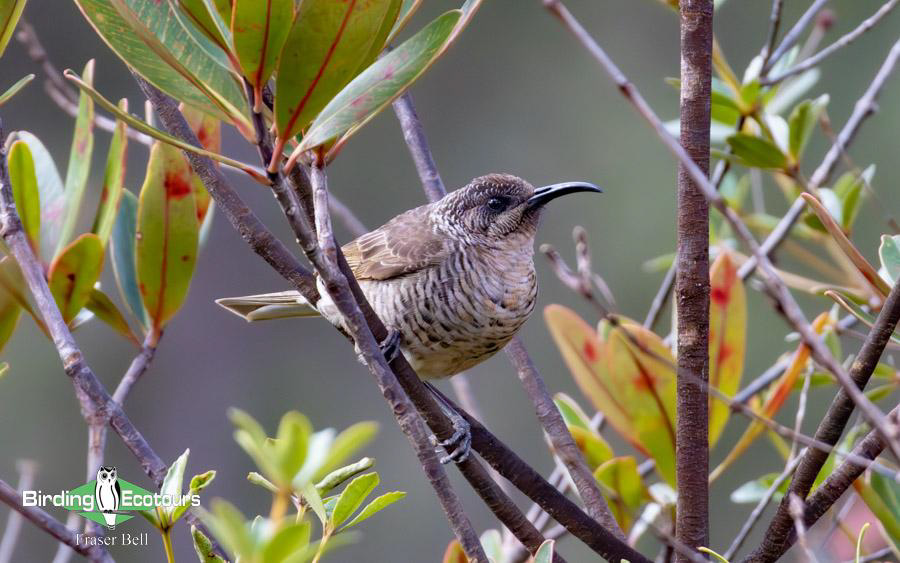
Barred Honeyeater is a distinctive New Caledonian endemic.
Day 3, 5th September 2025. Transfer north and birding the Parc des Grandes Fougères
We checked out of our Nouméa hotel early and headed north along Grand Terre’s west coastline, adding Swamp Harrier and large numbers of Wild Turkeys to our lists during the drive. Once in the Farino area, we birded along some quiet roads with brilliant views of Sacred Kingfisher, New Caledonian Friarbird, White-breasted Woodswallow, and more. The highlights, however, were watching a group of New Caledonian Crows actively jumping through the canopy and cawing to one another, made even more entertaining by the presence of two young birds loudly demanding food. We also had close views of the hulking Goliath Imperial Pigeon,raucous Horned Parakeet, and a pair of stunning Red-throated Parrotfinches, which quickly flew out of a Casuarina tree just as we lifted our cameras.
On arrival at the Parc des Grandes Fougères (Great Ferns Park) we ate our picnic lunch, entertained by a squabbling trio of Shining Bronze Cuckoos, and active groups of South Melanesian Cuckooshrikes and Striated Starlings, against a gorgeous backdrop across the lush forests below. This afternoon we walked a trail that wound through the prehistoric forests. New Caledonian Whistler, New Caledonian Streaked Fantail, and Melanesian Flycatcher accompanied us during the walk, and we had repeat views of all of these localized species. Our main target was the fabulous Cloven-feathered Dove, which we could hear calling throughout our time at the park. After a bit of time following the song we found a stunningly beautiful male perched in the lower canopy, and we all had great long looks at this star species as it continued calling across the forest. This has to be one of the most interesting and beautiful doves in the world, with such vivid colors and white fluffy trousers, combined with an odd body and head shape (see photo in the tour summary).
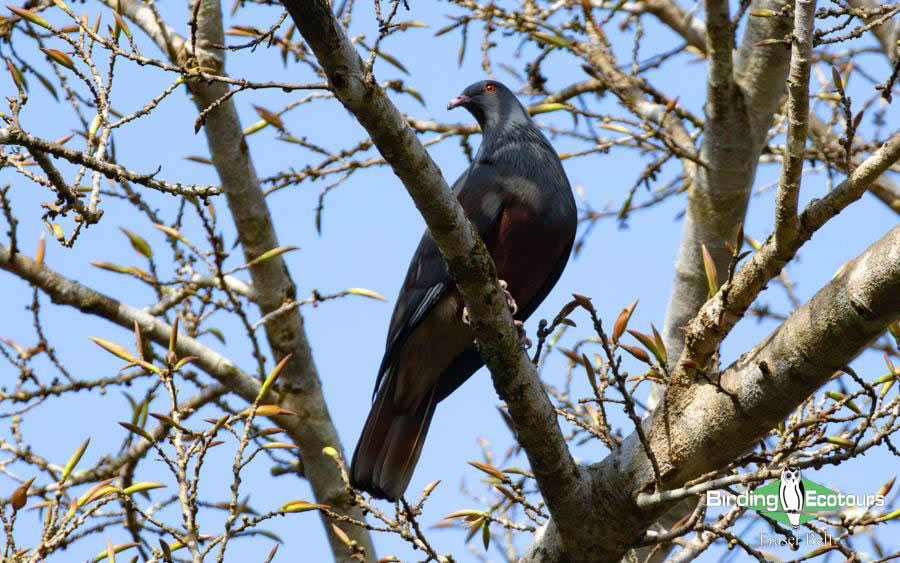
New Caledonia is home to the largest arboreal pigeon in the world, the Goliath Imperial Pigeon.
Being immersed in the forests of Parc des Grandes Fougères was a big tour highlight. Walking amongst this wonderful forest, with the giant tree ferns towering above us (and the other trees!), and watching Kagus foraging around us is a memory that will last. The Kagus were brilliant to watch as they crept stealthily across the forest floor alongside us. We heard their electronic static-like hisses as they called to one another and even got to see them raising their crests and opening their wings a few times. A pair of New Caledonian Cuckooshrikes were a surprise, given that they are much less numerous here than at the Parc de la Rivière Bleue and, after a special effort for them, we saw a lone New Caledonian Parakeet – though the views needed to be improved as the individual stayed within the dense canopy.
Roadside birding on the way out of the park yielded our first of many Buff-banded Rails and Australasian Swamphens, and a brief view of the gorgeous Pacific Emerald Dove. The rest of the afternoon was spent transferring to our beachside resort in Deva, near Bourail. Arriving at the plush resort, we were greeted by hordes of Wild Turkeys, Australasian Swamphens andnonnative Javan Deer (a threatened species in their native range on Java), and enjoyed some well-earned rest and a walk on the beach after another day full of highlights.
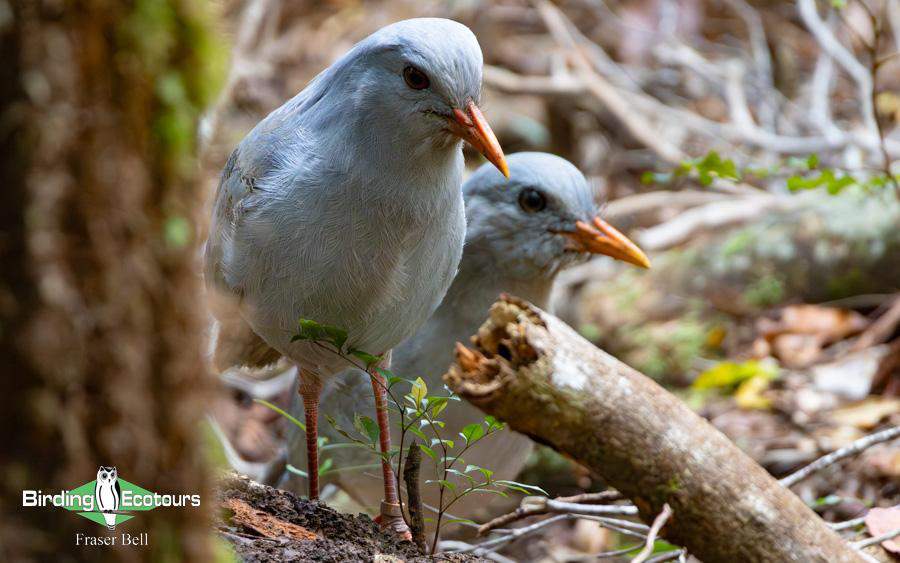
The adult and young Kagus that foraged quietly around us in Parc des Grandes Fougères. The young, seen in the foreground with brown on its wing and a band on its leg, has been marked to monitor this Endangered species (IUCN/BirdLife International).
Day 4, 6th September 2025. Birding near Bourail
After a good rest we awoke to a beautiful sunrise across the resort grounds, then checked out and traveled north to bird roadside thickets and grasslands. Here, we quickly found a couple of pairs of New Caledonian Thicketbirds, our major target for the day, these gave brief but good looks as they darted between tussocks and grass stalks. Another specialty here was the Red-throated Parrotfinch, we saw a handful of these beautiful tree-dwelling finches but, unfortunately, typically in flight. Continuing birding in the area we finally saw the endemic White-bellied Goshawk. Alerted by the call, we followed where it landed and had scope views of this compact hawk, before the mobbing of several species caused it to move on. Traveling out of the area we found another White-bellied Goshawk, this one remained perched and we were all able to enjoy excellent views. After a stop to pick up our lunch and a mid-morning drink, we traveled to the coast to target another elusive species. On arrival to the forest gardens in the Poe Beach area, we could hear the characteristic bubbling coos of Red-bellied Fruit Dove, a species endemic to New Caledonia, Vanuatu, and southern Solomon Islands. After a short search, we found a stunningly beautiful male calling from the top of a low tree, and everyone had brilliant looks at this star bird. What a great morning!
We had our lunch next to the beach, while listening to the calls of Red-bellied Fruit Dove and watching White-rumped Swiftlets zooming overhead. During lunch, a Red-throated Parrotfinch flew into the tree next to our picnic bench, causing us all to grab our optics and cameras, but again, the bird left all too soon. After lunch we traveled to one of the best wetland sites on Grand Terre. Here we added Grey Teal, Hardhead, Australasian Grebe, and Dusky Moorhen to our trip list, and enjoyed close views of nesting Welcome Swallow, Pacific Black Duck, Little Black Cormorant, and Little Pied Cormorant. While continuing to scan at this picturesque wetland, a distant bird caused a stir, which was re-found much closer and revealed to be the first record of Eurasian Coot for New Caledonia! Even though the species is common and widespread across much of the Palearctic, Asia, and Australia, it was a thrill finding this vagrant in New Caledonia.
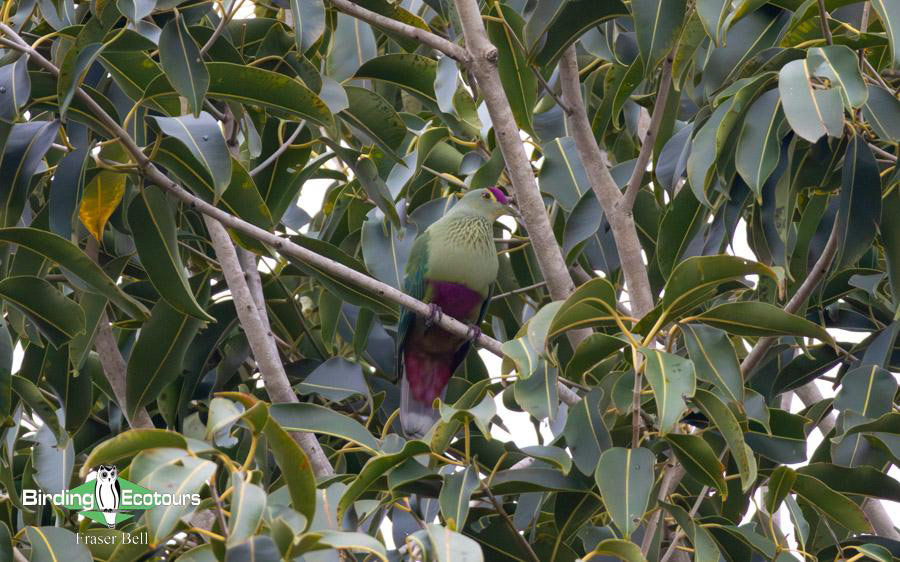
This magnificent male Red-bellied Fruit Dove was one of the tour highlights.
Birding the dry forests around the wetlands, we found a busy flock of lovely Chestnut-breasted Mannikins, an Australian species introduced here, alongside White-faced Heron, Sacred Kingfisher, White-breasted Woodswallow, and many others. We drove back to Nouméa in heavy rain, so did not succeed in finding nonnative Zebra Dove, but did chance upon an exotic Indian Peafowl on the roadside. We rounded off the day in one of the many excellent restaurants close to our hotel, celebrating yet another great set of birding highlights.
Day 5, 7th September 2025. Return to the amazing Parc de la Rivière Bleue
Although rain threatened the day, we headed off before first light, hopeful to see New Caledonia’s rarest species. Fueled by French pastries and coffee, we entered the fantastic Parc de la Rivière Bleue for our second full day at this truly unique park. We had left our hotel earlier in hope of connecting with the Critically Endangered (IUCN/BirdLife International) Crow Honeyeater, a species becoming rarer each year. Our efforts instantly paid off and we watched a female singing from high in an Araucaria tree for over ten minutes. It was amazing to see her red wattles and hear her call ringing out across the forest. Despite this amazing start to the day, the rain then moved in, so we toasted our success with a second breakfast before further exploring the park.
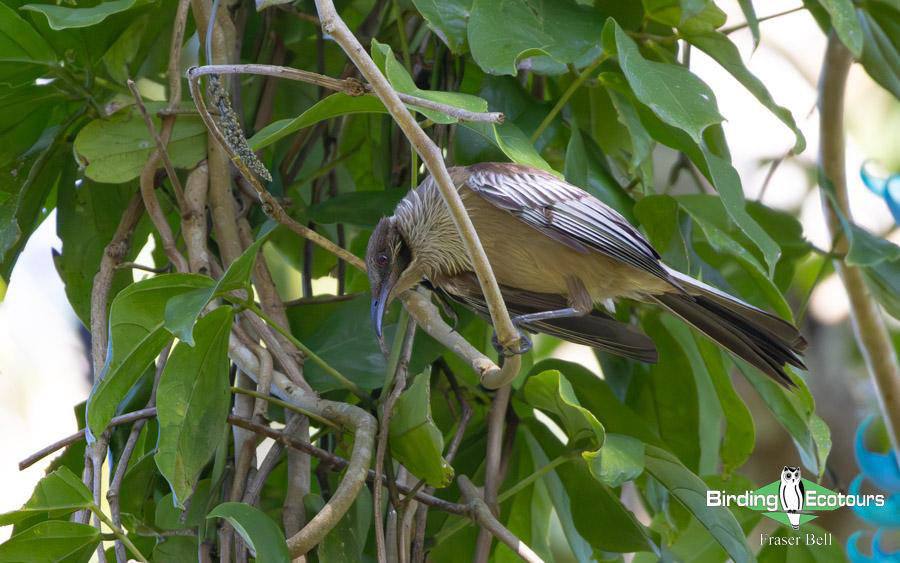
New Caledonian Friarbirds are entertaining to watch and striking in appearance, with silvery blue-grey wings and tail, and throat feathers that look like brushstrokes.
Most important was the New Caledonian Parakeet, a sleek parakeet clade in a brilliant green with a stylish red eye stripe. We enjoyed several encounters and listened to their cheerful calls echoing across the unique landscapes. Other species seen well included Barred Honeyeater, New Caledonian Myzomela, New Caledonian Cuckooshrike, Long–tailed Triller, and a nice immature White-bellied Goshawk. Over our picnic lunch we were able to watch a host of forest species up close, with the stars being the characterful Yellow-bellied Flyrobin, which came right up to our benches and grabbed any wayward crumbs! Of course, no visit to the park is complete without quality time spent in the company of the comical and bold Kagu. We saw them on three different occasions throughout the day, and each was a joy. We made an additional stop in Nouméa to see nesting Nankeen Night Heron, before we enjoyed the final evening meal of the tour.
Day 6, 8th September 2025. Tour conclusion
After the run of early starts, we decided to have a more relaxed morning with breakfast at the hotel followed by some local birding in Nouméa. After enjoying the buffet, we walked along Nouméa’s southern sea front. High winds made for slower birding at times, but it was still an enjoyable walk with amazingly close views of Osprey in flight and perched near a nest site, and we added Wandering Tattler and Lesser Frigatebird, bringing the tour list to 71 species seen during our six days. It had been an incredible experience exploring such a beautiful location with a fun group of birders. It was no surprise that Kagu won bird of the trip without competition, though the beautiful Cloven-feathered Dove was a very worthy runner-up. I very much look forward to returning to New Caledonia to show more birders what a truly outstanding destination it is.
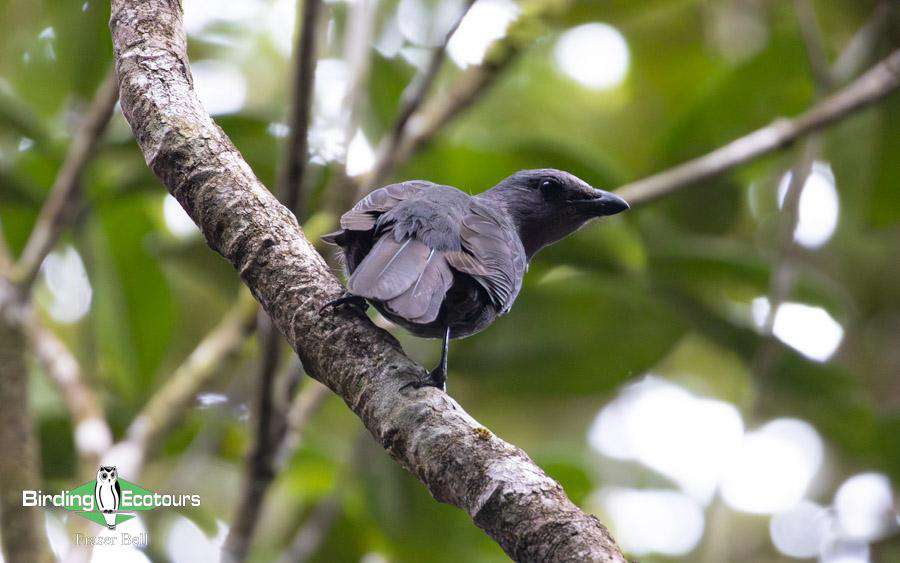
New Caledonia Cuckooshrike can be hard to see well, but we managed to see them on three different occasions.
Bird List – Following IOC (Version 15.1 / March 2025)
All species were seen. The following notation after species names is used to show conservation status following BirdLife International: CR = Critically Endangered, EN = Endangered, VU = Vulnerable. (Endemic) = New Caledonia endemic birds.
| Common Name | Scientific Name |
| Ducks, Geese, Swans (Anatidae) | |
| Pacific Black Duck | Anas superciliosa |
| Grey Teal | Anas gracilis |
| Hardhead | Aythya australis |
| Pheasants & Allies (Phasianidae) | |
| Wild Turkey (Introduced) | Meleagris gallopavo |
| Indian Peafowl (Introduced) | Pavo cristatus |
| Swifts (Apodidae) | |
| Satin Swiftlet | Collocalia uropygialis |
| White-rumped Swiftlet | Aerodramus spodiopygius |
| Cuckoos (Cuculidae) | |
| Shining Bronze Cuckoo | Chalcites lucidus |
| Fan-tailed Cuckoo | Cacomantis flabelliformis |
| Pigeons, Doves (Columbidae) | |
| Rock Dove (Introduced) | Columba livia |
| Metallic Pigeon | Columba vitiensis |
| Spotted Dove (Introduced) | Spilopelia chinensis |
| Pacific Emerald Dove | Chalcophaps longirostris |
| Red-bellied Fruit Dove | Ptilinopus greyi |
| Cloven-feathered Dove (Endemic) | Drepanoptila holosericea |
| Goliath Imperial Pigeon (Endemic) | Ducula goliath |
| Rails, Crakes & Coots (Rallidae) | |
| Buff-banded Rail | Hypotaenidia philippensis |
| Dusky Moorhen | Gallinula tenebrosa |
| Eurasian Coot | Fulica atra |
| Australasian Swamphen | Porphyrio melanotus |
| Grebes (Podicipedidae) | |
| Australasian Grebe | Tachybaptus novaehollandiae |
| Sandpipers, Snipes (Scolopacidae) | |
| Wandering Tattler | Tringa incana |
| Gulls, Terns, Skimmers (Laridae) | |
| Greater Crested Tern | Thalasseus bergii |
| Silver Gull | Chroicocephalus novaehollandiae |
| Kagu (Rhynochetidae) | |
| Kagu (Endemic) – EN | Rhynochetos jubatus |
| Frigatebirds (Fregatidae) | |
| Lesser Frigatebird | Fregata ariel |
| Cormorants, Shags (Phalacrocoracidae) | |
| Little Pied Cormorant | Microcarbo melanoleucos |
| Little Black Cormorant | Phalacrocorax sulcirostris |
| Great Cormorant | Phalacrocorax carbo |
| Herons, Bitterns (Ardeidae) | |
| Nankeen Night Heron | Nycticorax caledonicus |
| Pacific Reef Heron | Egretta sacra |
| White-faced Heron | Egretta novaehollandiae |
| Ospreys (Pandionidae) | |
| Osprey | Pandion haliaetus |
| Kites, Hawks, Eagles (Accipitridae) | |
| Brown Goshawk | Tachyspiza fasciata |
| White-bellied Goshawk (Endemic) | Tachyspiza haplochroa |
| Swamp Harrier | Circus approximans |
| Whistling Kite | Haliastur sphenurus |
| Kingfishers (Alcedinidae) | |
| Sacred Kingfisher | Todiramphus sanctus |
| Old World Parrots (Psittaculidae) | |
| Horned Parakeet (Endemic) – VU | Eunymphicus cornutus |
| New Caledonian Parakeet (Endemic) – VU | Cyanoramphus saisseti |
| Coconut Lorikeet | Trichoglossus haematodus |
| Honeyeaters (Meliphagidae) | |
| Barred Honeyeater (Endemic) | Glycifohia undulata |
| New Caledonian Myzomela (Endemic) | Myzomela caledonica |
| New Caledonian Friarbird (Endemic) | Philemon diemenensis |
| Grey-eared Honeyeater | Lichmera incana |
| Crow Honeyeater (Endemic) – CR | Gymnomyza aubryana |
| Australasian Warblers (Acanthizidae) | |
| Fan-tailed Gerygone | Gerygone flavolateralis |
| Woodswallows, Butcherbirds & Allies (Artamidae) | |
| White-breasted Woodswallow | Artamus leucorynchus |
| Cuckooshrikes (Campephagidae) | |
| South Melanesian Cuckooshrike | Coracina caledonica |
| New Caledonian Cuckooshrike (Endemic) | Edolisoma anale |
| Long-tailed Triller | Lalage leucopyga |
| Whistlers & Allies (Pachycephalidae) | |
| New Caledonian Whistler (Endemic) | Pachycephala caledonica |
| Rufous Whistler | Pachycephala rufiventris |
| Fantails (Rhipiduridae) | |
| Grey Fantail | Rhipidura albiscapa |
| New Caledonian Streaked Fantail (Endemic) | Rhipidura verreauxi |
| Monarchs (Monarchidae) | |
| Southern Shrikebill | Clytorhynchus pachycephaloides |
| Melanesian Flycatcher | Myiagra caledonica |
| Crows, Jays (Corvidae) | |
| New Caledonian Crow (Endemic) | Corvus moneduloides |
| Australasian Robins (Petroicidae) | |
| Yellow-bellied Flyrobin (Endemic) | Cryptomicroeca flaviventris |
| Bulbuls (Pycnonotidae) | |
| Red-vented Bulbul (Introduced) | Pycnonotus cafer |
| Swallows, Martins (Hirundinidae) | |
| Pacific Swallow | Hirundo javanica |
| Welcome Swallow | Hirundo neoxena |
| Grassbirds & Allies (Locustellidae) | |
| New Caledonian Thicketbird (Endemic) | Cincloramphus mariae |
| White-eyes (Zosteropidae) | |
| Silvereye | Zosterops lateralis |
| Green-backed White-eye (Endemic) | Zosterops xanthochroa |
| Starlings, Rhabdornises (Sturnidae) | |
| Striated Starling (Endemic) | Aplonis striata |
| Common Myna (Introduced) | Acridotheres tristis |
| Old World Sparrows, Snowfinches (Passeridae) | |
| House Sparrow (Introduced) | Passer domesticus |
| Waxbills, Munias & Allies (Estrildidae) | |
| Chestnut-breasted Mannikin (Introduced) | Lonchura castaneothorax |
| Red-throated Parrotfinch (Endemic) | Erythrura psittacea |
| Common Waxbill (Introduced) | Estrilda astrild |
| Total seen | 71 |
| Total heard only | 0 |
| Total recorded | 71 |
Mammal List – Following Mammalwatching.com (November 2024)
| Common Name | Scientific Name |
| Flying Foxes (Pteropodidae) | |
| Pacific Flying Fox | Pteropus tonganus |
| Deer (Cervidae) | |
| Javan Deer | Rusa timorensis |
| Pigs (Suidae) | |
| Feral Pig | Sus scrofa |
| Total seen | 3 |
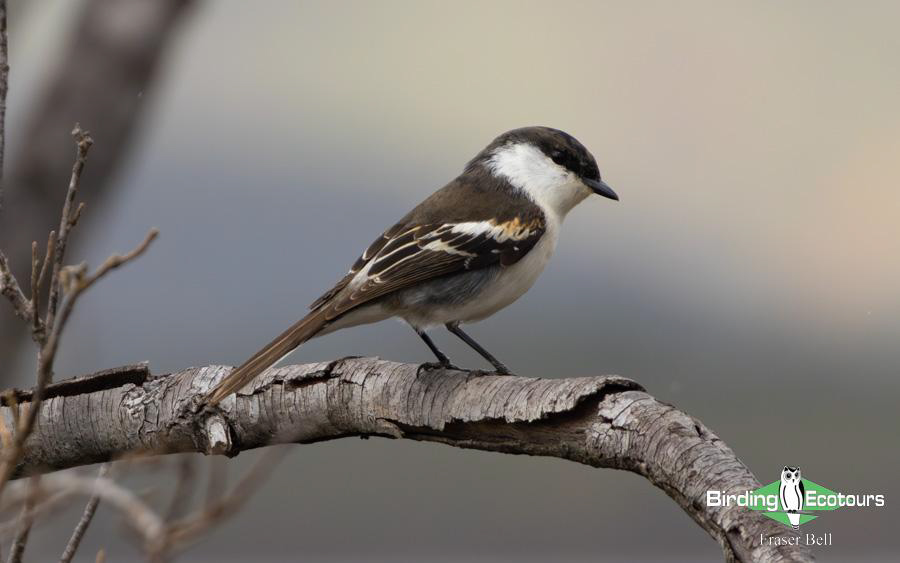
We saw the localized Long-tailed Triller on most days while birding in New Caledonia.
DOWNLOAD TRIP REPORT
This is a sample trip report. Please email us ([email protected]) for more trip reports from this destination.
NEW CALEDONIA: KAGU AND OTHER ENDEMICS: TOUR-SPECIFIC INFORMATION
TOUR OUTLINE
On this short New Caledonia birding tour, we visit the special French collectivity of New Caledonia, situated in the southwest Pacific Ocean. During this New Caledonia bird tour, we will visit the best birdwatching sites on New Caledonia’s main island, Grande Terre, on which we target many beautiful species endemic to New Caledonia, or Melanesia.
Our six-day tour starts and ends in the capital, Nouméa, which we use as our base to explore the phenomenal Parc de la Rivière Bleue, the most bird-rich site on the island. Here, we search for many species, with our two main targets the Critically Endangered (BirdLife International) Crow Honeyeater and the iconic, flightless Kagu, an Endangered (Birdlife International) species also known as the “ghost of the forest”. After a full day in the world famous park, we travel north to another impressive national park, the Parc des Grandes Fougères (Great Tree Fern Park), dominated by prehistoric giant tree ferns. While here, we continue targeting endemics, which might include the massive Goliath Imperial Pigeon, the beautiful Cloven-feathered Dove, or the White-bellied Goshawk. Our next stop is the grasslands near Bourail, where we search for the super-skulking New Caledonian Thicketbird, followed by some productive wetland birding. We finish our tour with another full day in the Parc de la Rivière Bleue to try to gain further views of Kagu and other stunning endemics.
Aside from these species, there are many other amazing species we target while birding in New Caledonia, including Horned Parakeet, New Caledonian Parakeet, Barred Honeyeater, New Caledonian Myzomela, New Caledonian Friarbird, New Caledonian Cuckooshrike, Yellow-bellied Flyrobin, Striated Starling, Red-throated Parrotfinch, and the famous tool-using New Caledonian Crow, all of which are endemic to New Caledonia. Melanesian endemics we will target include Satin Swiftlet, Grey-eared Honeyeater, South Melanesian Cuckooshrike, Long-tailed Triller, Southern Shrikebill, and Melanesian Flycatcher.
There are a lot of colorful and incredible birds possible on this New Caledonia bird watching tour, which pairs perfectly with our Fiji and Samoa Pacific Birding Adventure, where we search for the beautiful trio of Golden, Orange and Whistling Dove, along with Taveuni Silktail and many other brilliant Fijian endemic birds.
DAILY ACTIVITIES, PHYSICAL REQUIREMENTS, AND TOUR PACE
During our six-day New Caledonia Kagu and other Endemics Birding Adventure we explore the western coastline of Grande Terre, the main island, starting in Nouméa in the south and traveling as far north as the Bourail area. The tour moves at a moderate pace. While we spend long periods in the field to maximize birding time, often starting early and staying out for most of the day, we base ourselves at a single hotel for four of the five nights (split in two two-night stays), which makes for a more relaxed experience. The one night at a different location falls in the middle of the tour, with travel periods between the two two-night stays, creating a well-paced itinerary. Birding will take us through some of New Caledonia’s excellent national parks, open coastal habitats, gardens, wetlands, grasslands, and forest. We will mostly bird along small roads or tracks, though some narrow forest trails will be used in more densely vegetated areas. There will be good opportunities for photography throughout the trip, which has been designed to allow ample time to enjoy and photograph the beautiful endemic birds on offer. For example, we have included two full days in the superb Parc de la Rivière Bleue, to give us the best chance of seeing key targets, including the iconic Kagu.
The tour is generally considered easy to moderate in terms of physical effort. For much of the birding, we will be largely vehicle-based, only walking short distances to the birding areas. On other occasions, we will walk for longer periods of up to 2 miles (3.2 kilometers) along quiet roads, tracks, or forest trails. For example, when we target the elusive New Caledonian Thicketbird in the Bourail grasslands or explore Parc des Grandes Fougères (Great Tree Fern Park), we may walk for longer periods. These walks will be taken slowly to ensure they are manageable for everyone. Walking sticks or hiking poles may be helpful for those who prefer extra stability and are essential for anyone who feels unsteady on their feet, as your safety is our top priority. We visit during the dry season, when daytime temperatures are mostly comfortable, typically ranging from 68 to 75°F (20 to 24°C), further details are provided in the “Weather/Climate” section below.
Our birding days typically begin around 5:30 to 6:00 a.m., with either a simple early breakfast or a boxed breakfast taken into the field. Bird activity usually drops off during the middle of the day, when we will break for lunch and take time to rest and refresh, followed by afternoon birding before our group evening dinner. Most walks will be optional, and when we are returning to the same accommodation, anyone who prefers not to join a particular activity can choose to stay and rest. While there are no very long drives during the tour, the longest being the two-hour transfer between Nouméa and Bourail, there will be a fair amount of driving each day to reach birding sites. Given the distance to some of these sites, we may not return to the hotel between morning and afternoon sessions, instead using the vehicle as a base.
SPECIES RECORDING (BIRD LISTS AND ANIMAL LISTS)
Ahead of the tour we will email you a detailed daily itinerary complete with meeting/arrival instructions. We will provide you with a printed blank diary page within the itinerary document so that you can note down any names of birding sites that you may want to log. On the first night of the tour you will be provided with a printed version of the same itinerary. Each evening your tour leader will go through this with you to let you know any specifics to be aware of for the following day (e.g. clothes and equipment needed, breakfast time, time for leaving hotel, key target birds we will be looking for, etc.).
Attached to the itinerary document will be a bird list and list of other animals possible on the tour (or a blank list to write them in as we go). We follow the latest IOC (International Ornithological Congress taxonomy) for birds and International Union for Conservation of Nature (IUCN) for all other animals recorded during the tour so all itineraries and checklists follow these taxonomies.
Each evening we will go through the daily bird and animal lists, logging all the species from the day. The listing session is optional, we realize that some of our clients aren’t fussed about the listing aspect, but others are. If you do not want to take part in the nightly bird list that is perfectly fine, but it is a useful way to remember what was seen during the day, so recommended.
Birding Ecotours leaders maintain eBird checklists from all birding activities during a tour (from unexpected roadside stops to planned birding activities). Tour leaders will share these eBird lists with all participants who use eBird, if desired. Just make sure to provide your eBird user details to the tour leader at the beginning of the tour for us to be able to do this, unfortunately we can’t retrospectively go back and share past checklists after the tour. We will also provide you with an eBird trip report for the tour where we will add our photos taken on the tour and you are welcome to include your own too.
After the tour you will be emailed a PDF copy of a written trip report, this will be in the form of an illustrated daily diary and will include a complete checklist of all wildlife recorded. If the tour leader manages to get any interesting photographs these will be included in the trip report. Leader photos may also be added to our Flickr page and will be added into a “trip report gallery” which you can view, download, and share.
PASSPORT, VISA, AND ENTRY REQUIREMENTS
Most visitors do not require a visa to visit New Caledonia for stays of up to 90 days within a 180-day period, including travelers from the United States, Canada, the United Kingdom (UK), and Australia, but please consult the official New Caledonian immigration pages for more information. Citizens of the United States, Canada, and Australia must have at least six month’s validity remaining in their passports, and at least one blank page for entry and exit stamps. British (UK) citizens require at least three months’ validity and two blank pages, but please check these websites for any recent changes to ensure you are suitably covered. You will need to show proof of your onward flight from New Caledonia and valid medical insurance. You may also be asked to provide evidence of sufficient funds to support your stay, and proof of booked accommodation (please refer to the final itinerary document).
Citizens of other countries not listed above should check their own governments’ advice and contact their nearest embassies/consulates for up-to-date regulations and requirements. For example, while proof of vaccinations are not needed to enter New Caledonia, if you are traveling from a country listed as a Yellow Fever transmission risk you will need to show proof of vaccination. Please make sure that you bring a photocopy of your passport with you on the tour, to be kept in a different location to your original passport, in case of loss/damage. This can be kept with other important documents such as vaccine certificates, emergency contact details, and insurance documents. Digital copies of these saved on a “cloud” system can also be useful.
TRAVEL INSURANCE
Travel insurance is mandatory for entry to New Caledonia, and we strongly recommend that you purchase comprehensive trip cancellation insurance to protect against unexpected events that might cause delays and interruptions to travel. Your insurance should also cover illness, medical issues, hospital expenses, accidents, repatriation, loss of luggage or valuable items, flight delays or cancellations, and include medical evacuation and repatriation. You may be required to present proof of insurance on arrival and departure. Your policy should cover the entire duration of your trip and include any pre-existing conditions. Failure to purchase adequate insurance could be costly if something unexpected occurs.
HEALTH, VACCINATIONS, AND MEDICAL CONDITIONS
We recommend you are up to date with routine vaccinations for visiting New Caledonia, including measles-mumps-rubella (MMR), tetanus, diphtheria, polio, whooping cough, shingles, chickenpox, flu, and COVID-19. In addition, Hepatitis A and B are strongly recommended for all travelers. Malaria is not present in New Caledonia, however, Dengue fever, Zika Virus and other insect-borne diseases such as chikungunya, although uncommon, are present and so we recommend taking personal protective measures. These include using mosquito repellent, wearing long pants, and long-sleeved shirts, particularly at night when mosquitos and other biting insects are active.
There is also a risk of Leptospirosis, particularly after heavy rain or flooding. We are not visiting during the wet season so the risk is considered low, but we recommend avoiding swimming in freshwater areas in rural regions and wearing closed shoes out on the trails. If you are traveling with medication, be aware that some drugs legal in your home country may be restricted or prohibited in New Caledonia. Bring a sufficient supply for your trip and carry your medicine in its original packaging, along with a prescription or doctor’s letter stating the name of the medication, your dosage, and that it is for personal use. Please carefully read the CDC traveler advice which contains information on required vaccinations to enter New Caledonia. Please note, you will require a valid Yellow Fever Certificate if you are traveling from a region where yellow fever is present.
As per our general Terms and Conditions, we require you to notify us at the time of registering for this tour of any medical conditions that we should know about (these should include, but not be limited to, walking/mobility issues, allergies, heart conditions, diabetes, epilepsy, long-term illnesses etc.). While in New Caledonia we will not be far from the country’s main hospital in the capital Nouméa, where we will be based for four of the five nights during the tour, however, we do make some excursions into more remote areas and during these times we will be further from hospitals and medical facilities. Please make sure that you are covered with suitable medical insurance (with medical evacuation included) in case of an emergency while on the tour, because without insurance the cost for medical care is likely to be extremely high. While New Caledonia has good healthcare facilities, more serious cases may require evacuation to Australia. In addition, many hospitals/medical clinics will require payment upfront for treatment and these costs could be much higher than what you might expect at home.
SAFETY
While New Caledonia is generally considered a safe destination, significant civil unrest broke out in May 2024 in response to constitutional reforms, with incidents of rioting, arson, looting, and roadblocks, particularly in Nouméa and Greater Nouméa. The situation has since improved, but protests may still occur without warning, often resulting in road closures and disruption to transport and essential services. Demonstrations are more likely around key dates, including New Caledonia Day on 24 September. Around such times, local authorities may impose curfews or additional restrictions at short notice.
Petty crime such as pickpocketing, bag-snatching, and car break-ins occur, and roadside incidents, including stone-throwing and roadblocks, have been reported during periods of unrest. Throughout the tour, we will always be accompanied by a local guide or a trusted transfer service when outside accommodation grounds. We also maintain constant communication with local guides and accommodation providers, who have reported no issues at the sites we visit and roads we travel on, but if conditions change we will avoid these sites and seek an alternative.
During the tour, please keep vehicle windows closed and watch your belongings closely. If you are traveling independently before or after the tour, we recommend avoiding walking alone at night, securing valuables, using licensed taxis, and withdrawing cash from ATMs located inside banks or hotels. This is general advice, for more information please visit your respective government advisory. Refer here for US citizens, here for Canadian citizens, here for UK citizens, and here for Australian citizens, and please check these websites for any recent changes to ensure you are suitably covered.
There are no large terrestrial mammals or venomous snakes to worry about in New Caledonia, but some species of spider, scorpion, and centipede are venomous, and a few plants are toxic or spiked. Always check your boots before putting them on, and watch where you place your hands and feet. Please do not just grab plants without checking for any potentially sharp or painful spikes. Sturdy walking boots are essential for protecting your feet and ankles, and it’s important to always follow your guide’s advice.
SWIMMING ADVICE AND MARINE LIFE
Marine life presents the greater risk from wild animals in New Caledonia. Coastal waters around the islands are home to aggressive Tiger and Bull Sharks as well as venomous species like the Blue-ringed Octopus, Box and Moon Jellyfishes, Crown-of-Thorns Starfish, and Stonefish. In New Caledonia there are beautiful beaches, and there may be the opportunity to swim or snorkel at these between birding, or at the start or end of the tour. While shark nets are installed at beaches around Nouméa, they are not present at Poe Beach near Bourail, so increased caution is needed here. Several serious shark attacks have occurred in recent years. Only swim when green flags are displayed (orange flags indicate dangerous conditions; red flags mean swimming is prohibited). Swim only during daylight hours, at patrolled beaches, and avoid ports, marinas, murky waters, and swimming after heavy rain.
We recommend always following local advice before entering the water, due to strong currents, riptides, and potentially hazardous marine animals. Lifeguards are present on Nouméa beaches, and staff at our Bourail hotel are knowledgeable about local waters and marine life. If snorkeling, never touch marine life and always stay alert.
FOOD AND WATER
In New Caledonia, tap water is generally safe to drink in Nouméa and other large urban areas, and filtered water is typically available at both hotels. While out birding in rural areas, it is best to drink bottled water. We provide an ample supply of drinking water in our vehicle throughout the tour, so please bring a refillable water bottle to help reduce plastic waste. Ice is considered safe in high-standard restaurants and hotels, but it is best avoided in rural areas or from street stalls.
The food in New Caledonia is a fusion of Western and Melanesian cuisine with strong French influences. Seafood is common, and vegetarian options are widely available, making the food suitable for most palates. Dietary preferences are well catered for at the hotels we use, which are accustomed to hosting international guests. Some breakfasts are boxed and taken away with us, but others will be at our accommodation, as we expect all evening meals will be, with lunch at a café or restaurant after morning birding. Mealtimes will generally fall within normal hours but may be adjusted depending on our birding and travel schedule. If you require food at specific times (e.g. to coordinate with medication), we recommend bringing snacks such as cereal bars, protein bars, or dried fruit. We are unlikely to stop at convenience stores, so it’s best to bring any preferred items from home.
CURRENCY
The official currency in New Caledonia is the CFP franc (XPF). Banknotes are issued in denominations of 500, 1,000, 5,000, and 10,000 XPF, with coins available in 5, 10, 20, 50, 100, and 200 XPF. Local currency is used for all everyday transactions. While some tourist establishments may accept major foreign currencies like US dollars or euros, paying in local currency usually offers better value. Visa, Mastercard, and American Express are widely accepted in shops, though American Express is less commonly accepted outside Nouméa. It is advisable to carry some cash for smaller purchases, as card use is limited outside Nouméa and our hotels, and cash also helps avoid poor exchange rates or card surcharges. Check with your card provider before departure to ensure your card will work in New Caledonia and whether you need to notify them of your travel plans.
It is possible to exchange or withdraw money at La Tontouta International Airport on arrival, but it may be more convenient to bring local currency with you or arrange this at your departure airport. A small amount of local cash will be useful for personal expenses not covered in the tour cost and for any gratuities. Please refer to the itinerary document for a detailed list of what is and isn’t included. Always remain vigilant when using ATMs for your safety and security.
WEATHER/CLIMATE
New Caledonia, located in the tropical South Pacific just south of the Equator, has a mild, sunny climate year-round, shaped by trade winds and two main seasons. We visit in late August or early September during the cooler, drier season (June to September), which is ideal for birding. Daytime temperatures on Grande Terre, the main island, typically range from 68 to 75°F (20 to 24°C), with night-time temperatures dropping to around 59 to 64°F (15 to 18°C), and even cooler in higher-elevation areas such as areas in Parc de la Rivière Bleue. Rainfall is low at this time of year, particularly on the west coast where we spend much of the tour. Heavy showers are still possible during the dry season, especially when we are birding in the forests, but these are usually brief and localized. The risk of tropical storms or landslides is low in the dry season.
Sea temperatures hover around 72°F (22°C), making conditions suitable, if slightly cool, for swimming or snorkeling. Trade winds keep conditions comfortable and skies generally clear, making late August and early September one of the best times to explore New Caledonia. To make the most of the cooler mornings and peak bird activity, we will start early each day and adjust our schedule as needed according to temperature and weather conditions.
ELECTRICITY AND COMMUNICATION
The power plug sockets in New Caledonia are of Type F, which are also used throughout Europe (but not in the UK or Ireland), including France, Germany, and Spain among others. This socket only works with plug F. The standard voltage is 220 volts (V), and the standard frequency is 50 hertz (Hz). Further details (and photos) can be found here.
Adaptors are likely to be needed for some visitors from overseas; you may also need a voltage converter and should be careful with certain appliances that utilize different frequencies. You can use your electric devices in New Caledonia if the standard voltage in your country is between 220 – 240 V (as in the UK, Europe, and most of Asia and Africa). These small deviations are considered by manufacturers. If the standard voltage in your country is in the range of 100 – 127 V (as in the US, Canada, and most South American countries), you will need a voltage converter. You could also consider a combined power plug adapter/voltage converter to save space.
The hotels we use have Wi-Fi, but it is possible that the Wi-Fi may sometimes drop, so be aware that the connection may be unstable, particularly when away from Nouméa. Phone coverage is typically good near urban areas, but will be patchy when we are birding.
TRANSPORTATION AND SEAT ROTATION
We will travel in a comfortable, air-conditioned minibus throughout our New Caledonia birding tour. For some birding excursions, particularly in more remote areas, such as the Bourail grasslands when searching for New Caledonian Thicketbird, we will use 4×4 SUV- or Landcruiser-type vehicles. Depending on weather conditions, 4x4s may also be required for other sites, such as the excellent Parc de la Rivière Bleue. When using 4x4s, the group may be split between two vehicles traveling in convoy, one driven by the local guide and the other by your Birding Ecotours guide.
A seat rotation policy will be in place to ensure everybody has equal opportunities within the vehicle throughout the tour. Motion sickness will not excuse you from our seat rotation policy and if you are prone to motion sickness you should ensure you bring the necessary medication. We require that you are fit and flexible enough to maneuver yourself to the back of the vehicle when it is your turn to sit in that position. Tour participants should be mindful of the extra equipment they bring into the general seating area of the vehicle (rather than the luggage section) and should ensure they do not clog up general thoroughfare or extra seats with camera equipment, tripods, etc. from both a comfort and a health and safety perspective.
ACCOMMODATION
We stay in two clean, comfortable hotels during the tour, with four nights in Nouméa, and one near Bourail. The hotel near Bourail is set in extensive grounds close to a stunning beach, while our Nouméa accommodation is a modern, upmarket hotel accustomed to hosting international travelers. Occasionally, we may need to use alternative accommodation for logistical reasons, but full details will be provided ahead of the tour. Both hotels offer private en-suite bathrooms with hot water, 24-hour electricity, Wi-Fi, and air conditioning (or a fan). Laundry services are available throughout. We use “standard” rooms, as is typical for most group birding tours globally, and these are deemed sufficient for most participants. If you would like to upgrade to a higher standard of room, such as a “luxury” option, this may be possible in some locations depending on availability. Please note there will be an extra charge for room upgrades, and contact us as early as possible to discuss options. Please note that while in the Bourail areas there is always a slim chance of power outages which may result in loss of electricity, Wi-Fi, or hot water, at least temporarily.
WHAT TO BRING:
Clothing
When we visit New Caledonia in August and September, the weather is comfortable, with warm to hot days, so lightweight, breathable clothing is recommended. Quick-drying birding clothes in muted colors work best, and sun protection such as a wide-brimmed hat, sunglasses, and sunscreen is recommended. Most nights will be mild, but some folks may feel cool, especially with coastal winds, so we suggest packing layers, including a sweater or jumper. Long pants are useful not only for warmth in the evenings but also for protection against insects in forested areas.
Although this tour takes place during the dry season, occasional tropical showers are still possible, so a light, packable rain jacket or poncho is advised, and a small travel umbrella can also be useful. Two sets of footwear are ideal: lightweight, closed-toe hiking boots or shoes for birding, and a pair of comfortable sandals, flip-flops, or trainers for relaxing at the hotel. Swimwear is recommended, as our accommodations have swimming pools or beachfront access.
Equipment
Binoculars are essential for all birding, and a camera is highly recommended if you plan to document your sightings (many of the New Caledonia species are world famous and brilliant). A dry bag is also recommended to protect valuables such as passports, phones, wallets, and cameras if we encounter rain. If you are unsteady on your feet or concerned about uneven ground, a walking stick or hiking pole is strongly recommended and may be essential for forest trails or rough tracks.
Insect repellent with high-concentration DEET or a suitable alternative is strongly advised, particularly for time spent in lowland and coastal rainforest where biting insects are common. A small hand towel or washcloth may come in handy for drying off gear or cleaning up in the field, particularly in wetter rainforest locations. A small personal first aid kit is worth carrying, especially for minor cuts, blisters, or insect bites. For those interested in snorkeling, equipment is often available for hire at the beaches, but do bring your own if you want to ensure you can have the gear with you, particularly your own mask/goggles if you require a prescription version.
FIELD GUIDES
Birds of Melanesia (Dutson, 2011) – The best bird guide available for the majority of Melanesia, including New Caledonia. It covers all species found in the region, though some names and taxonomy are now outdated. The illustrations are good, with plates positioned opposite concise identification summaries. While there are no range maps, the guide instead uses color bars to indicate island presence, which is more practical given the broad geographic coverage. The book is thick, reflecting the diversity and high number of single-island endemics, but only half is dedicated to field-useful plates and summaries; the second half contains more detailed species accounts that are less useful in the field.
SEABIRDS The New Identification Guide (Harrison, Perrow, and Larsson, 2021) – The best available field guide covering all known seabirds, with brilliant illustrations, the plates are well laid out and is comprehensive yet succinct.
The Herpetofauna of New Caledonia (Bauer, and Sadlier, 2000) – This is the only comprehensive field guide to the reptiles and amphibians of New Caledonia. It is a photographic guide with good-quality images that aid identification, but it relies on a key that requires some understanding of herpetological anatomy and terminology, which can make it challenging to use. The species descriptions are thorough and informative, though their level of detail makes the book less practical for quick reference in the field.
Reef and Shore Fishes of the South Pacific (Randall, 2005) – This is the most comprehensive guide to inshore fishes of the South Pacific, covering nearly 1,500 species from New Caledonia, Fiji, Samoa, and surrounding islands. Each species is illustrated (mostly underwater photos) and includes brief identification notes, size, distribution, habitat, and biology. This guide is targeted at divers and snorkelers.
USEFUL APPS AND WEBSITE RESOURCES
Merlin – an app that can help you identify birds by sight (from photos) and sound (from recordings) and is a useful tool to aid bird identification. The app is getting expanded all the time with new data and regional information so is worth keeping an eye on. We recommend downloading the Melanesia pack for this tour.
eBird – there is a wealth of information contained on this website and the mobile app is now excellent and useful too. Photo, video, and sound galleries are available for practically every species in the world through The Cornell Lab of Ornithology’s Macaulay Library.
Aves Vox – a good app that enables the downloading of bird songs and calls from the xeno-canto website onto your cell phone.
IOC World Bird List – this website contains all the latest details on the world of global bird taxonomy. You can read about newly described species, splits (creation of a new species) and lumps (deletion of a species) of existing species, and plenty of other important information.
